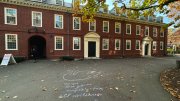Revolutionary Generation: Harvard Men and the Consequences of Independence, by Conrad Edick Wright ’72 (University of Massachusetts Press, $34.95). Wright is the Ford editor of publications at the Massachusetts Historical Society and in that capacity has come to know the 204 members of the Harvard College classes of 1771 through 1774, who were present for the action during the founding years of the Republic. In what he calls “an investigation of growing up and growing old in revolutionary New England,” Wright gives readers a collective biography of this privileged but not cloistered lot.
Stoic Warriors: The Ancient Philosophy behind the Military Mind, by Nancy Sherman, Ph.D. ’82 (Newman Communications, $26). Today’s soldiers early on learn an old lessonto suck it up, to endureobserves Sherman, University Professor of philosophy at Georgetown.
The Xeno Chronicles: Two Years on the Frontier of Medicine inside Harvard’s Transplant Research Lab, by G. Wayne Miller ’76 (Public Affairs, $26). David H. Sachs ’63, M.D. ’68, Russell/Warner Lambert professor of surgery, puts parts of genetically engineered pigs, whose organs have been designed not to be rejected by their recipients, into baboons. His hope is that xenotransplantation cross-species transplantationwill one day save multitudes of people. Miller, an award-winning reporter at the Providence Journal, writes of his two years in Sachs’s lab, of how science works, of the people who do it, and of the ethical issues it can raise abundantly.
One Bullet Away: The Making of a Marine Officer, by Nathaniel Fick, KSG ’07 (Houghton Mifflin, $25). Fick quotes Thucydides: “We should remember that one man is much the same as another, and that he is best who is trained in the severest school.” After majoring in classics at Dartmouth, Fick went to a severe school and emerged a member of the Marine’s elite First Reconnaissance Battalion, leading troops in Afghanistan and Iraq. He tells what it takes to master the making of war.
Eakins Revealed: The Secret Life of an American Artist, by Henry Adams ’71 (Oxford University Press, $40). “The traditional literature on [Thomas] Eakins has pushed forward an obvious falsehood, that he was an individual of almost unparalleled honesty and virtue and that his art directly reflected the perfections of his character,” writes Adams, professor of American art at Case Western Reserve. Instead, the man behind his brutal and harsh paintings wrestled with exhibitionism, obsessive compulsive syndrome, misogyny, castration anxiety, sexual abuse, incest, and manic depression.
Meet the Beatles: A Cultural History of the Band That Shook Youth, Gender, and the World, by Steven D. Stark ’73 (HarperEntertainment, $26.95). A commentator on popular culture (for National Public Radio and others), Stark entertainingly assesses the meaning of the Beatles in the history of our times. One recurrent theme is that “if not always intentionally, the Beatles helped feminize the culture.”
California: A History, by Kevin Starr, Ph.D. ’69 (Random House, $24.95). The author, University Professor at the University of Southern California in Los Angeles, has chronicled the Golden State inso farsix much-acclaimed, fat volumes. Now comes a history of what he calls a “nation-state” complete in one volume. Its final chapter is “Arnold!” Both California and Schwarzenegger are self-invented and are equally improbable.
Help, It’s Broken! The Fix-It Bible for the Repair-Impaired, by Arianne Cohen ’03 (Three Rivers Press, $11.95, paper). Wrench-wielder Cohen, always upbeat, is a former Ledecky undergraduate fellow of this magazine.
An Old Blue Corpse: A New Haven Mystery, by John Morton Blum ’43, Ph.D. ’50, LL.D. ’80 (Publish America, $19.95, paper). Yale’s Sterling professor of history emeritus has written 18 books of history and now one murder mysteryfeaturing poisoned chocolates administered during the search for a new president of Yale. Students of academe will admire its light and verity.





